Sheep
 From Nwe
From Nwe |
Sheep |
||||||||||||||
|---|---|---|---|---|---|---|---|---|---|---|---|---|---|---|
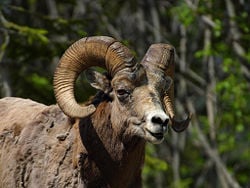 Bighorn sheep |
||||||||||||||
| Scientific classification | ||||||||||||||
|
||||||||||||||
| Species | ||||||||||||||
O. aries (domestic sheep) |
A sheep is an individual of any of the woolly mammal species that comprise the genus Ovis. All sheep are even-toed ungulates (hoofed mammals) and members of the bovid family ( Bovidae), along with goats, antelopes, bison, buffalo, and cattle. Domestic sheep (Ovis aries) were one of the first animal species domesticated by humans and have had an important role in human life for thousands of years. There are also several species of wild sheep.
Sheep are usually stockier than other bovines and some have horns that are more divergent than those of goats. Sheep have scent glands on the face and hind feet. They have a four-chambered stomach, which plays a vital role in digesting, regurgitating, and re-digesting food.
Domestic sheep are important for their wool, milk, and meat (which is called mutton or lamb).
Male sheep are called rams, females are called ewes, and the young are called lambs. Males are sometimes also called "bucks" or "tups." The adjective applying to sheep is ovine and the collective terms for sheep are flock and mob. The term herd also is occasionally used in this sense.
Wild sheep
Wild sheep are mostly found in hilly or mountainous habitats. They are fairly small compared to other ungulates; in most species, adults weigh less than 100 kg (220 lbs) (Nowak 1983). Their diet consists mainly of grasses, as well as other plants and lichens. Like other bovids, their digestive system enables them to digest and live on low-quality, rough plant materials. Sheep conserve water well and can live in fairly dry environments. Their bodies are covered by a coat of thick hair to protect them from cold. The coat contains long, stiff hairs, called kemps, and a short woolly undercoat, called fleece, which grows in fall and is shed in spring (Clutton-Brock 1999).
Wild sheep are social animals and live in groups, called flocks. This helps them to avoid predators and also helps them stay warm in bad weather by huddling together. Flocks of sheep need to keep moving to find new grazing areas and more favorable climate as the seasons change. In each flock, there is a sheep, usually a mature ram, that the others follow as a leader (Clutton-Brock 1999).
In wild sheep, both rams and ewes have horns, with the rams' horns being much larger. The horns of a mature bighorn ram can weigh 14 kg (30 lbs), as much as the rest of its bones put together. Rams use their horns to fight with each other for dominance and for the right to mate with females. In most cases, they do not injure each other because they hit each other head to head and their curved horns do not strike each other's bodies. They are also protected by having very thick skin and a double-layered skull (Voelker 1986).
Wild sheep have very keen senses of sight, smell, and hearing. When detecting predators, wild sheep most often flee, usually uphill to higher ground. However they can also fight back. The dall sheep has been known to butt wolves off the face of cliffs (Voelker 1986).
There are some differences of opinion among experts on how wild sheep should be divided and named as species. One group of sheep species consists of the bighorn sheep (Ovis canadensis) and dall sheep (O. dalli) of western North America and the closely related snow sheep (O. nivicola) of Siberia. Another group is more closely related to domestic sheep and includes the Asiatic mouflon (O. orientalis), which is thought to be the ancestor of domestic sheep, the urial (O. vignei), which also might have contributed to domestic sheep ancestry, and the argali (O. ammon). These three species are native to central and western Asia, with the Asiatic mouflon living in the mountains of Turkey to southern Iran, the urial from northeastern Iran to northwestern India, and the argali in inner Asia (Tibet, Himalayas, Atlay Mountains, etc.)
The European mouflon (O. musimon) is found on the islands of Corsica and Sardinia in the Mediterranean Sea. It is thought to be descended from an early population of domestic sheep brought there by humans in prehistoric times (Clutton-Brock 1999; Huffman 2006; Nowak 1983).
Domestication
The domestic sheep is thought to be descended from the wild mouflon of central and southwest Asia (the Asiatic mouflon, O. orientalis). DNA analysis suggests there are two ancestral sources for the genetic makeup of domestic sheep, but a second subspecies contributor has not been identified. The urial has a higher number of chromosomes (58) than the domestic sheep (54), making it an unlikely ancestor, although it interbreeds with the mouflon. The argali sheep has 56 chromosomes and the Siberian snow sheep has 52 chromosomes.
The process of domestication of sheep seems to have started about 10,000 years ago in southwestern Asia, with some evidence for domestication dating to 9000 B.C.E. in Iraq (Kreb and Krebs 2003). It is not known how sheep came to be associated with humans. It has been suggested that humans followed wild sheep flocks, killing some when they needed meat but also protecting them from other predators. It is also possible that sheep preferred to stay near human settlements to eat crops or weeds that grew nearby, or to lick the salt found in human urine, or because predators would avoid humans. It is also possible that hunters sometimes found newborn lambs and brought them home to keep as pets (Clutton-Brock 1999).
An important factor in their domestication seems to be that sheep started to relate to humans as their flock leaders. This made it possible for a single shepherd to control a large flock of sheep. Dogs were also used to help control and protect the flocks. Because sheep can thrive in dry or hilly country that is not suited for crops, the keeping of flocks gave early human communities an important additional resource. Ewes began to be milked and the fleece that sheep shed each spring was gathered and spun into yarn to make clothing.
Shepherds would select the sheep with the most desirable characteristics to give each year's new lambs and sheep slowly changed under domestication. They became smaller, slower, and calmer than their wild ancestors. Different breeds arose depending on different environmental conditions and standards of selection. In most breeds, ewes became hornless.
Modern sheep
There are now 200 to 300 or more breeds of sheep (Voelker 1986, OSU 2003). Those bred mainly for wool include Merino, Rambouillet, Romney, and Lincoln. Drysdale is a sheep bred specifically for carpet wool. Breeds of meat sheep include Suffolk, Hampshire, Dorset, Columbia, and Texel. Hair class sheep resemble the original domesticated breeds and are useful for meat and leather. They are prolific and highly resistant to disease and parasites.
In the twentieth century, the invention of artificial fibers took away some of the market for wool, although it is still very important and remains the most popular fiber for cold weather clothing. Sheep hides with the fleece still attached are an important item and are used for coats, boots, rugs, and other products.
The production and consumption of sheep meat, called mutton if from mature sheep and lamb if from young ones, is declining in the United States, but is increasing in China due to improved economic conditions. In India and the Middle East, religious restrictions on the eating of the meat of cattle and pigs also contribute to growing sheep meat consumption (Miller 1998).
Ewes' milk is used in the production of cheese and yogurt in many parts of the world. Well-known sheep milk cheeses include the Roquefort of France, the Brocciu of Corsica, the Pecorino of Italy, and the Feta cheese of Greece.
The world population of sheep in 2005 was just over one billion. China has about 170 million sheep, most of which are raised for meat. Australia, with about 100 million, and New Zealand, with about 50 million (much more than their human population), dominate the world export trade in sheep products. Large numbers of sheep are also found in other Asian countries, Europe, Africa, and South America (Miller 1998).
Wool
Wool is the fiber derived from the fur of animals of the Caprinae subfamily, which includes sheep and goats. However, the hair of certain species of other mammals, such as alpacas and rabbits, may also be called wool.
Wool has two qualities that distinguish it from other types of hair or fur: it has scales that overlap like shingles on a roof and it is crimped; in some fleeces of domestic sheep the wool fibers have more than 20 bends per inch. Fleece is the name for the woolen coat after it has been sheared from the animal, but before it has been processed.
Historically, in some breeds of sheep, the fleece was not shed in spring, but grew year-round and was cut off, or shorn, usually once a year in the spring; producing the material wool. As sheep herding spread over Asia and Europe, wool became one of the most commonly used fibers for clothing and a very important product in commerce and trade. Wool's scaling and crimp make it easier to spin and felt (matting, condensing, and pressing) the fleece. Those characteristics help the individual fibers attach to each other so that they stay together. Because of the crimp, wool fabrics have a greater bulk than other textiles and retain air, which causes the product to retain heat. Insulation also works both ways; Bedouins and Tuaregs of the North African desert use wool clothes to keep out the heat.
The amount of crimp corresponds to the thickness of the wool fibers. A fine wool like merino may have up to a hundred crimps per inch, while the coarser wools like karakul may have as few as one to two crimps per inch. Hair, by contrast, has little if any scale and no crimp and thus little ability to bind into yarn. On sheep, the hair part of the fleece is called kemp. The relative amounts of kemp to wool vary from breed to breed, and make some fleeces more desirable for spinning, felting, or carding into batts for quilts or other insulating products.
Wool is generally a creamy white color, although some breeds of sheep produce natural colors such as black, brown (also called moorit), and gray.
Wool straight off a sheep has a high level of grease, which contains valuable lanolin, as well as dirt, dead skin, sweat residue, and vegetable matter. This state is known as "grease wool" or "wool in the grease." Before the wool can be used for commercial purposes it must be scoured, or cleaned. In less processed wools, vegetable matter may be removed by hand, and some of the lanolin left intact through use of gentler detergents. This semi-grease wool can be worked into yarn and knitted into particularly water-resistant mittens or sweaters, such as those of the Aran Island fishermen. Lanolin removed from wool is widely used in the cosmetics industry.
Sheep in religion
Sheep are common symbols in culture and religion. In Catal Huyuk in ancient Turkey, clay heads of rams, along with heads of bulls, are found in shrines 8,000 years old (Budlansky 1992). The ancient Egyptian fertility god Heryshaf was depicted as a man with the head of a ram. In Chinese Buddhism, the ram was one of the animals that attended the birth of Buddha and is honored by being one of the signs of the Chinese zodiac. The ram Aries, is also one of the signs of the Western zodiac.
The three Abrahamic religions, Judaism, Christianity, and Islam, developed in the sheepherding areas of the Middle East and sheep and sheepherding play important parts in all three. According to the Bible, Abraham, Jacob, Moses, and David all worked as shepherds. In Judaism, lamb is traditionally eaten at Passover to commemorate the Hebrews' escape from Egypt. Abraham's sacrifice of a ram, which was substituted for his son, is commemorated by Muslims each year in the festival of Eid ul-Adha. Sheep are mentioned symbolically in the Bible many times; perhaps most famously in Psalm 23, which begins "The Lord is my shepherd." In Christianity, shepherds attended the birth of Jesus, and he is referred to as the Good Shepherd and the Lamb of God.
References
ISBN links support NWE through referral fees
- Budiansky, S. 1992. The Covenant of the Wild. New York: William Morrow and Company. ISBN 0688096107
- Clutton-Brook, J. 1999. A Natural History of Domesticated Mammals. Cambridge, UK: Cambridge University Press. ISBN 0521634954
- Huffman, B. 2006. The Ultimate Ungulate Page. Retrieved January 13, 2007.
- Krebs, R. E., and C. A. Krebs. 2003. Groundbreaking Scientific Experiments, Inventions and Discoveries of the Ancient World. Westport, CT: Greenwood Press. ISBN 0-313-31342-3
- Miller, S. 1998. Sheep and Goats. United States Department of Agriculture, Foreign Agricultural Service. Retrieved January 13, 2007.
- Nowak, R. M., and J. L. Paradiso. 1983. Walker's Mammals of the World. Baltimore: Johns Hopkins University Press. ISBN 0801825253
- Oklahoma State University (OSU). 2003. Breeds of Livestock: Sheep. Retrieved January 13, 2007.
- Parker, D. 2001. The Sheep Book. Athens: Ohio University Press. ISBN 0804010323
- Voelker, W. 1986. The Natural History of Living Mammals. Medford, NJ: Plexus Publishing. ISBN 0937548081
Credits
New World Encyclopedia writers and editors rewrote and completed the Wikipedia article in accordance with New World Encyclopedia standards. This article abides by terms of the Creative Commons CC-by-sa 3.0 License (CC-by-sa), which may be used and disseminated with proper attribution. Credit is due under the terms of this license that can reference both the New World Encyclopedia contributors and the selfless volunteer contributors of the Wikimedia Foundation. To cite this article click here for a list of acceptable citing formats.The history of earlier contributions by wikipedians is accessible to researchers here:
The history of this article since it was imported to New World Encyclopedia:
Note: Some restrictions may apply to use of individual images which are separately licensed.
↧ Download as ZWI file | Last modified: 02/03/2023 22:40:59 | 39 views
☰ Source: https://www.newworldencyclopedia.org/entry/Sheep | License: CC BY-SA 3.0
 ZWI signed:
ZWI signed: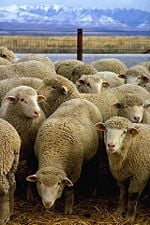

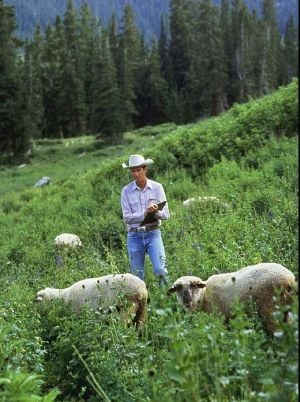
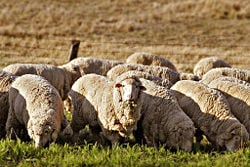


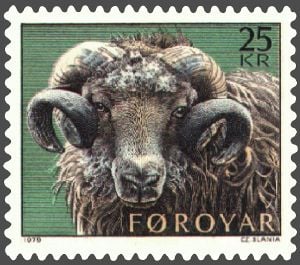
 KSF
KSF